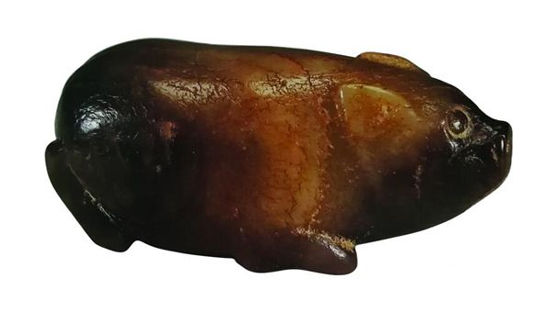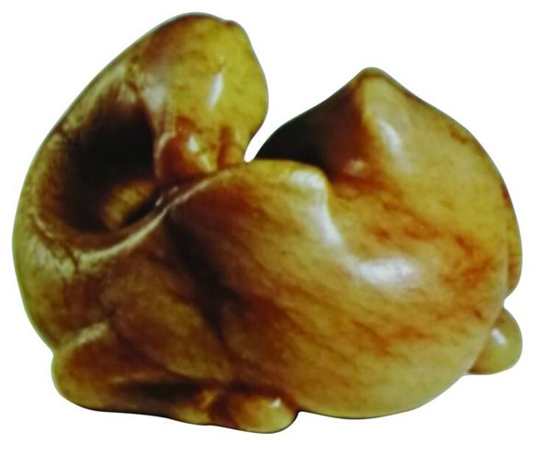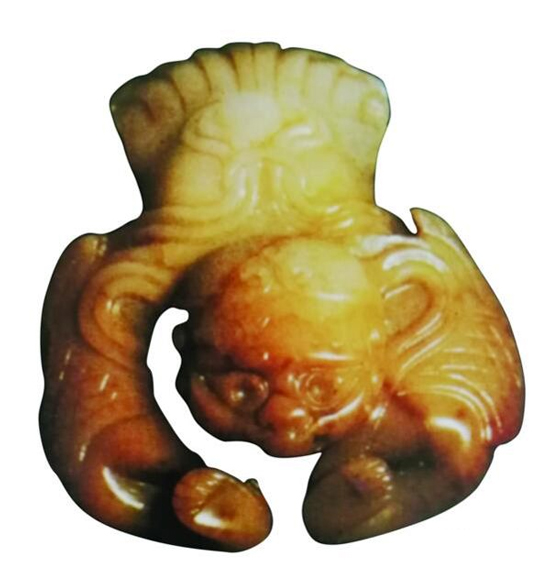In the Tang Dynasty in the heyday of China's feudal society, due to the development of the Western Region, Xinjiang Hetian jade was heavily imported into the mainland, making the jade articles of the Tang Dynasty mostly dominated by such materials. Although they are not produced in large quantities, they have new developments in their varieties and artistic styles, and they are more elaborate in quality. Therefore, the characteristics of jade carvings are very obvious. In particular, the literary function of the Tang Dynasty jade is more intimate and lovely than the Zhou Han jade. Among them, the ornaments and headwear in the jade articles of the Tang Dynasty are usually dominated by Xiaosheng jade, and most of them are animal images. For example, the three animal-shaped jade articles in the Asian Art Museum of San Francisco (hereinafter referred to as the 'Asian Art Museum') have the purpose of furnishings, play and decoration. For the name of the pig, there are many kinds of names in ancient China, the most popular of which are called 豕 (shÇ), 彘 (zhì), porpoise. And in the ancient sculpture sculptures of various pigs, especially the carving of jade pigs, the most artistic charm and artistic value. The Tang Dynasty jade pig tends to be realistic, and its shape and craft are more complicated than the jade carving of the Han Dynasty. figure 1 This is a collection of Tang Dynasty jade in the Asian Art Museum (Figure 1). It is 4.4 inches high and 9.2 cm wide and is engraved in a dark brown piece of jade. Short ears, round eyes, tight mouth, tail attached to the buttocks, fat body, short limbs, prone. Its shape is evenly distributed, the lines are simple and smooth, and the honing is excellent. And Yu's facial expression is gentle, the look is vivid and realistic, and the embarrassment is embarrassing. In particular, it is a method of engraving the Yin line, carving the outline of the jade, the limbs and the tail, and the technique is fierce and has a strong generality. At the same time, using only a few simple lines of bas-relief, it depicts the limbs of the jade, calm and fat, and full of strength. The solid shape of the jade body makes the characteristics of the Tang Dynasty jade articles very obvious, and it is an exquisite jade carving art. As for the camel animal, it is not unique in the Tang Dynasty in the history of China. However, at the time of the country, society and spiritual life, it was able to see it, making it a symbolic symbol of the Tang Dynasty. The camel obtained from the tribute and capture of the Datang Empire not only highlights the prosperity of the Tang Dynasty, but also plays an important role in agricultural production, commercial trade, and folk life. At the same time, as the most ideal means of transportation in the desert, camel also contributed greatly to the trade of the Silk Road of the Tang Dynasty. In view of this, the camel image is widely used in the works of the Tang Dynasty, and there is no shortage of jade. figure 2 The Asian Art Museum houses the Tang Dynasty jade camel (Fig. 2), which is 8.3 cm high. Its jade material is sugar-colored, warm and condensed, smooth and delicate, and the body is full of ochre, and the quality is excellent. The round camel's form is realistic, the look is quiet, and the proportion of the body is pinched accurately. His low eyebrows are pleasing to the eye, and he looks back, his posture is calm, and his form is mild. The jade camel outlines the contours of the body and four hooves with a simple line. The back has a double peak and the tail is attached to the buttocks. The shape of the whole machine is calm and stable, the image is exquisite and beautiful, the workmanship is rigorous and meticulous, the lines are stretched smoothly, the knife is confident and skillful, and the craft is extremely exquisite, which shows the skill of the Tang Dynasty artists. In addition, the image of this jade camel is both realistic and abstract, with distinct regional characteristics and characteristics of the times, and also shaped the style of the Tang Dynasty. For animals from outside the country, such as horses, lions, elephants, leopards, rhinoceros, parrots and other animals that were donated in the Western Region and Southeast Asia, the Tang Dynasty emperors were always full of curiosity like the rulers of the past. In order to get rich feedback, neighboring countries are also happy to contribute these animals. These animals, which are raised in the court beast, have a fixed supply of foodstuffs in addition to special care, which is an excellent treatment. When the Tang Palace meets major festivals, festivals or feasts, it will usually be played with a lot of fun. The five squares of the palace will lead the dance horse, lion tamer, tamer, and rhinoceros, with music or dance, or worship. It’s fun. Even in the Tang poems, there are many flaws in this phenomenon. image 3 This 5.7-cm-high Tang Dynasty jade tiara (Fig. 3) in the collection of Asian art museums is a sacred animal from the outside. This beast is yellow-brown, and the author concludes that the image should be a lioness outside the domain, making a crouching shape. His expression is leisurely, his image is mighty but not naughty. Big ears, ring eyes, flat nose, shut up, limbs lie on the ground, the whole body with a spiral pattern. In particular, the two legs that are stretched out are very anthropomorphic and unique. There is a fish on the left side, which seems to be eaten by the beast. The tail is long and decorative, and the function of the headwear is obvious. Compared with the shape and use of the jade wares of the Tang dynasty, this Tang dynasty jade tiara can be used as a headgear, as well as furnishings and play, which is obviously different. From the animal-shaped jade articles in the above three Asian art museums, the reader can see that the three-dimensional sculptures of the Tang Dynasty jade are small. In the carving, the large and main parts are captured, and different images have different expression techniques. In particular, the finely carved animal image details are often characterized by exaggerated techniques based on the proportion of normal body structures. At the same time, jade carving animals not only have loyal and rich pigs, hard-working camels, but also powerful lions and monsters, monsters, etc., with a wide range of subjects. Wool Braided Rug,Braided Wool Area Rug,Capel Wool Braided Rugs,Chunky Braided Wool Rug Hengshui Namei Imp.&Exp. Co.,Ltd. , https://www.nameirug.com


November 12, 2023